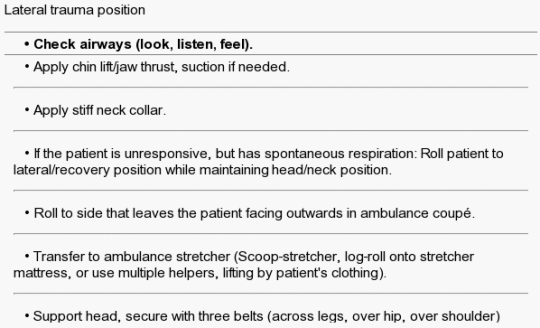Here’s a kick in the head, unless you are one of my Norwegian readers.
In the US and many (most) other countries, trauma patients are routinely transported strapped down in the supine position. It’s tradition. It’s easy. It gives prehospital providers pretty good access for whatever they need to do.
But it is right? Some patients, particularly those who have a diminished level of consciousness or severe obstructive sleep apnea, or both, may not do well in that position. In 2005, Norwegian Emergency Medical Services (NEMS) introduced the use of the lateral trauma position (LTP) across the country. Here is how it looks:

Five years later, a group from several hospitals across Norway conducted a survey of all ground and air EMS providers in the country. A few factoids:
- This one year survey included 202 of 206 ground EMS stations and 23 of 24 air EMS stations. Questionnaire response rate was about 50%
- Of supervisors at ground EMS units, 75% said that they had implemented LTP
- 67% of ground units had written policies for use and 73% had provided training
- Individual ground provider opinions were a bit different. 89% were familiar with LTP, but only 58% actually used it.
- Training seemed to be the key. Of ground providers given training, 86% were confident in using LTP, but of those not given training, only 58% were.
- Only 53% of air services used LTP, and only one had a protocol.
Here are the instructions on how to do it:

Bottom line: Interesting concept. Unfortunately there is little (or no) objective data to help us. The main thing available now is a 10 year experience with the lateral trauma position in Norway, and I have not seen any analyses of it. In my next post, I’ll review a meta-analysis published this year that does try to compare LTP vs supine positioning.
Related posts:
- Spine precautions and use of the long backboard
- How long to patients need to be on a backboard?
Reference: The lateral trauma position: what do we know about it and how do we use it? A cross-sectional survey of all Norwegian emergency medical services. Scand J Trauma 19:45, 2011.

